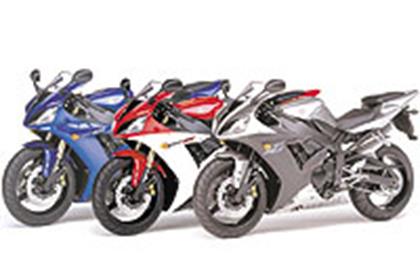Blueprint for the changes
IF you think the R1 doesn’t really look that different, that’s just the way Yamaha planned it. The firm reckons people like the way the R1 looks and simply want styling that’s a bit more futuristic. But while the bodywork shares the same vision as the original, everything else was up for grabs.
One key change is the riding position. The lower, one-piece handlebars and higher footrests are designed to make the R1 more comfortable for hard riding. Project leader Yoshikazu Koike, who has taken over from R1 godfather Kunihiko Miwa, said: ” The rider can be more aggressive through cornering. ”
Under the bodywork, the engine gets fuel injection for the first time. The Mikuni set-up differs from conventional systems in that it is partly controlled by piston valves in the throttle bodies which respond to the vacuum pressure of the intake ports when the throttle is opened. They’re designed to give the feel of a carburettor without the snatchiness of some systems, while retaining all the emissions benefits of injection.
There’s also a new airbox with the intake duct on the front instead of the rear. This ensures that incoming air is less likely to be warmed by the engine, making it around 5° cooler during normal riding. That helps the bike rev more cleanly at high revs – cooler air makes engines run more efficiently.
Inside the engine block are new bores and piston rings to reduce friction, conrods that are lighter yet also 10 per cent stronger, and valves that weigh 2g less.
The chassis gets a total makeover, too – it actually shares many of its dimensions with the rare R7 World Superbike. The engine has been raised by 20mm, resulting in better weight distribution for cornering. The wheelbase remains the same at 139.5cm, but the new frame is 30 per cent stiffer and there’s a new fully-detatchable subframe, making it easier to change the rear shock.
The forks boast stiffer springs, more adjustment and a shorter stroke to minimise the rocking sensation on the brakes and under power that the old bike suffered. At the back, there’s a new shock, also with stiffer spring rates and a wider range of adjustments.
The front-end geometry is changed, too. The fork offset is reduced from 35mm to 25mm, the same as the R7, and trail has increased from 92mm to 103mm, all of which helps the bike turn faster – one of Yamaha’s main aims. Lighter wheels also speed up cornering.
The Yamaha’s already legendary braking set-up gets new caliper pistons, sintered pads and more rigid brake hoses, all of which add up to improved power and feel.
Last, and probably least, new designs for the sprocket cover, chain, front mudguard and indicators save a few grams. Well, when you’ve got a bike that’s already as good as the R1, every little helps.
Swingarm:
The swingarm is the same length as the old one, at 582mm, but has actually been completely redesigned. It’s much stiffer and the swingarm pivot is mounted 17.5mm higher for quicker handling.
Exhaust:
A titanium four-into-two-into-one system replaces the four-into-one steel one to boost mid-range torque and high-rev character. Header pipes are 1kg (2.2lb) lighter and the grey end can has a catalytic converter.
Frame:
The chassis is so new Yamaha has given it a new name – Deltabox 3, replacing the original bike’s Deltabox 2. Not only is it stiffer and a different shape, but it has been painted black to resemble the R7.
Forks:
The forks are 2mm fatter than the old ones – up from 41mm to 43mm – which gives them more strength under braking. However, thinner tubes means there’s no weight penalty to pay.


